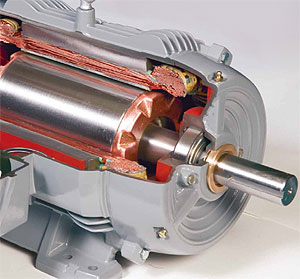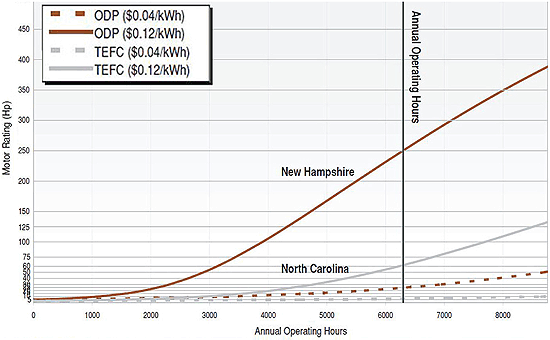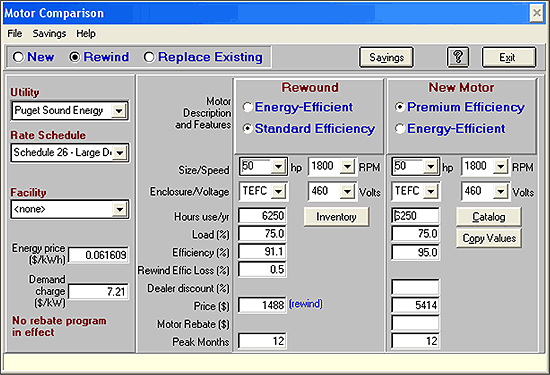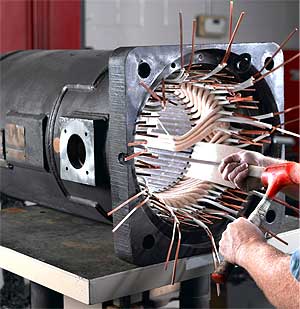![]() Download PDF Version [1.80 Mb]
Download PDF Version [1.80 Mb]
- Why Does My Company Need a Motor Management Plan?
- What is a Motor Management Plan
- The Key: Corporate Commitment
- The Motor Inventory: Where it All Begins
- Horsepower Breakpoint, MotorMaster+, and other Tools
- Repair or Replace?
- Views from the Operating Floor
Reducing losses and increasing profits by instituting a motor management plan is what this publication is all about. Subsequent articles in this three-part series will address in part II - motor failure policies, and purchasing specification; part III will examine repair specifications and preventive and predictive maintenance, respectively.

Why Does My Company Need a Motor Management Plan?
Electric motors tend to be taken for granted, even in technically advanced industries, but they are actually among our least well-managed industrial tools. Complacency breeds ignorance in plant management whose facilities depend on their motors. Bruce Benkhart, Director, Applied Proactive Technologies, Springfield, Massachusetts, has supervised hundreds of motor surveys on behalf of the New York State Energy Research Administration. Even he was surprised to learn that "Most facilities, commercial or industrial, are unaware of their motor population."
Motors that are not properly administered can (and do) cost businesses billions of dollars in wasted energy and operating costs annually. Neglecting motors can also lead to increased downtime and higher maintenance costs, not to mention the moments of near-panic when a critical motor fails and a production line grinds to a halt. Costs spike, profits fall.
You can begin to reduce losses and increase profits by instituting a motor management plan as outlined in this publication. Instituting sound motor failure policies, and purchase specifications and writing good repair specifications and preventative and predictive maintenance plans can further reduce your losses and increase profits. Those will be the subjects of subsequent articles in this three-part series on motor inventory management.
Back to TopWhat Is a Motor Management Plan
A motor management plan is just what its name implies: it's a set of actions, based on a thorough knowledge of a plant's motor inventory, that encompass all aspects of motor ownership. It spells out which types and sizes of motors are optimum for specific operations based on load profile, duty cycles and operating environment; it identifies which motors (or motor classes) should be repaired or replaced when they fail; which ones are critical to manufacturing continuity and which ones actually can, to a degree, be taken for granted. The plan can also spell out purchase and repair-shop best practices, and cite when and with what model one should replace fully functional motors. It can prioritize maintenance procedures and intervals and even enable maintenance personnel to predict motor life so as to avoid failure and schedule non-disruptive replacement times.
Back to TopThe Key: Corporate Commitment
A motor management plan is a flexible concept, easily tailored to the size and complexity of an organization and its motor population. There is no one-size-fits-all, but it is important to emphasize that developing and implementing a plan takes serious commitment by top management and training at the shop floor level. Fortunately, there are many excellent (and free!) tools available, several of which are described in this publication. Numerous organizations also provide assistance, both utilities and government agencies offer training and hands-on assistance by motor experts.
Selling the concept of motor management to the corporate suite should not be difficult because the plan offers real dollars-and-cents benefits to all areas of concern:
- Corporate management will appreciate improved reliability and uptime: Good motor management reduces the incidence of motor failures, reducing the fear of that awful day when a failed motor stops a production line and everyone waits while maintenance scrambles for a replacement;
- Financial officers will put reduced energy and operating costs at the top of their wish list. Industrial motor driven systems are energy gluttons, consuming more than 23% of all electricity produced in the United States. Consumption by motors averages around 66% in manufacturing plants, and in industries like water treatment and mining it can reach 90%. Good motor management can also optimize spares inventory levels, freeing up capital for use elsewhere.
- Engineering personnel look at improving performance and higher efficiency. The majority of industrial motors now in service in American factories are old. Many of them installed before 1997, when the Department of Energy (DOE) began mandating increased motor efficiency with Energy Policy Act of 1992 (EPAct).EPAct became law on October 19, 1992 and was effective on October 19, 1997. NEMA Premium® efficiency motors, which cost less to operate and offer higher reliability and longer warranties, are a major element of proper motor management. Their use is now mandated in many applications by the Energy Independence and Security Act of 2007 (EISA) which became effective on December 19, 2010.
- Purchasing managers see the value in a motor management plan. A management plan includes a survey of operating motors and of the spares inventory to provide assurance that NEMA Premium efficiency motors are readily accessible. Faster turnaround is attained. The plan should identify critical motors and ensure that such motors are always available, whether in spares inventory or nearby distributors' warehouse.
- Maintenance supervisors and facilities managers, who see motors daily from a close perspective, appreciate the benefits of programmed maintenance, better predictive capability, simplified replace vs. repair decisions, fewer motor failures, and,when failures do occur, transformation of what is often a panic operating mode into a smoothly executed maintenance project.
The Motor Inventory: Where It All Begins
Gilbert A. (Gil) McCoy, P.E. is an Energy Systems Engineer with the Washington State University (WSU) Energy Extension Office and a recognized motor expert. He and his teams have helped dozens of companies, the military and utilities develop motor management plans over more than 20 years, saving untold millions of dollars in the process. He emphasizes that beyond management commitment, the most important element of a good motor management plant is the initial survey, or motor-energy assessment, of all motors in the plant. "Motor-energy assessment is a systematic look at motors and motor-driven systems and their uses in an industrial plant," says Mr. McCoy. "The object is to identify the energy savings opportunities. The result of the assessment is a motor management plan. That plan not only indicates savings in dollars but also gives the user a path that describes how those savings can be obtained. The first step in a motor assessment is to obtain an in-plant inventory of both in-service and spare motors. Of particular importance is the efficiency class of each motor."
Efficiency is the fundamental driving force behind energy (and cost) savings in any motor management situation. It refers to the amount of shaft or brake power a motor produces compared to the amount of electrical input power it consumes at any given load level. There are currently three recognized efficiency classes:
- Standard Efficiency Motors are those machines built before 1992. Such motors were neither rated by nor required to meet minimum efficiency standards, and their efficiencies are quite low by current standards. Such motors can often be identified in the field by the fact that their nameplates do not display a nominal full-load efficiency value.
- Energy Efficient Motors, also known as EPAct Motors after the Energy Policy Act of 1992 (effective in 1997), mandated modest increases in efficiency. These motors must equal or exceed the minimum full load efficiency standards given in Table 12-11 of NEMA MG-1-2009, Revision 1-2010. Nameplates on these motors list a nominal efficiency value.
- NEMA Premium Efficiency Motors represent the next generation improvement in motor efficiency. The NEMA Premium efficiency standard, which initially covered three-phase general purpose motors up to 200 hp, was adopted in 2001 and was based on earlier recommendations by the Consortium for Energy Efficiency (CEE). Premium efficient motors are several percentage points more efficient than EPAct motors and conform to Tables 12-12 and 12-13 of NEMA MG-1-2009, Revision 1-2010. Table 12-13 expanded the NEMA Premium definition to include medium voltage motors in the range of 25-500 hp. The Energy Policy Act of 1992 at first made their use mandatory only in public buildings. The Energy Independence and Security Act of 2007 (EISA) mandated their use in other-than-government applications and extended coverage to several new categories of motors. EISA also extended coverage to higher horsepower motors, those up to 500hp, but limited mandatory use of NEMA Premium Efficiency motors to those smaller than 201 hp.
 Manufacturers also offer motors in sizes up to 200 hp that exceed minimum NEMA Premium efficiency levels, but such motors have not received formal recognition as an efficiency class as of the date of this publication. These induction motors achieve their high efficiencies through the use of better technology, higher quality materials and tighter production controls. One variety utilizes a die-cast copper (rather than aluminum) rotor, whose lower resistivity reduces electrical (I2R) losses, thereby increasing efficiency by one to five percentage points. It should be noted that even a one-point rise in efficiency in any class of motors, translates into very large savings over a motor's service life. Moreover, since lower electrical losses equate to lower heat gain in the motor the risk of damage to winding insulation is reduced. Therefore, these motors, whether NEMA Premium are expected to operate longer before failure. Data supporting that expectation is not available yet, but manufacturers generally offer longer warranties for these products.
Manufacturers also offer motors in sizes up to 200 hp that exceed minimum NEMA Premium efficiency levels, but such motors have not received formal recognition as an efficiency class as of the date of this publication. These induction motors achieve their high efficiencies through the use of better technology, higher quality materials and tighter production controls. One variety utilizes a die-cast copper (rather than aluminum) rotor, whose lower resistivity reduces electrical (I2R) losses, thereby increasing efficiency by one to five percentage points. It should be noted that even a one-point rise in efficiency in any class of motors, translates into very large savings over a motor's service life. Moreover, since lower electrical losses equate to lower heat gain in the motor the risk of damage to winding insulation is reduced. Therefore, these motors, whether NEMA Premium are expected to operate longer before failure. Data supporting that expectation is not available yet, but manufacturers generally offer longer warranties for these products.
Having sorted out the plant's motors by efficiency category, must be collected from all relevant nameplate data from all relevant motors, i.e., those from which energy/cost savings can be realized. This data includes make and model, horsepower rating, synchronous and full-load speed, voltage rating, frame size, enclosure type and special or definite purpose requirements for such application as washdown, severe or inverter-duty. A comprehensive motor management plan would, in addition, require historical data such as cost, plant application, location and date of installation, plus failure and repair/rewind history. Some companies' motor management plans call for the immediate replacement of "problematic" motors at the outset based on recurring maintenance requirements.
Back to TopHorsepower Breakpoint, MotorMaster+, and Other Tools
Creating the motor inventory requires looking at the nameplate of every motor in the plant, or in the interest of reducing personnel costs, just assessing the critical motors, as described below, then recording the data. Large plants may house several thousand operating motors and several hundred more as spares, making data-gathering a daunting task. Mr. McCoy and other motor experts recommend establishing a screening process to reduce the number of motors that need to be assessed.
 Figure 1. Typical Horsepower Breakpoint graph showing values for two utility rates. (Courtesy Advanced Energy Corporation)
Figure 1. Typical Horsepower Breakpoint graph showing values for two utility rates. (Courtesy Advanced Energy Corporation)One such expert is Kitt Butler, Director, Motors and Drives at Advanced Energy Corporation (AEC), Raleigh, North Carolina. It should be pointed out that AEC was the first independent laboratory in the U.S. to gain certification for testing motor efficiency, a service it has offered globally since the early 1990s. Mr. Butler recommends a screening process, also developed at AEC, which involves calculating a limit, called a "Horsepower Breakpoint". The breakpoint defines the motor size for a given duty cycle, at which it becomes cost-effective to replace an operating motor with a new NEMA Premium Efficiency model. Graphically, horsepower breakpoint is the point at which plots of motor rating and annual operating hour data cross for a given utility rate, Figure 1. It is calculated based on motor size (hp), nameplate efficiency, annual operating hours and the cost of electricity.
Making the breakpoint calculation before engaging in the full motor assessment quickly establishes a limit for groups of motors operating under similar circumstances. This eliminates the need to assess all such motors, since the repair/replace decision is already known.
Perhaps the most popular motor assessment tool in current use is MotorMaster+ software that is available by request at AMO Tools Help Desk. This tool is a data management application with which users can compare the cost of repair with the cost of new replacement for industrial motors under any operating conditions and for any utility rate, Figure 2. The databases upon which the software relies are updated periodically by the WSU Extension Energy Program. Databases include nameplate information from thousands of commercially available motors, prices and dealer discounts, plus repair and installation costs. Modules embedded within the software provide the ability to conduct batch analyses and calculate energy and cost savings, project simple payback periods, conduct life-cycle analyses, log maintenance action for both motors and driven equipment, manage spare inventories, verify savings and display aggregate energy and dollar savings from implemented energy efficiency measures at the facility or corporate level. Results can be stored, electronically distributed and/or printed.
 Figure 2. Savings calculation screen from MotorMaster+, DOE's popular motor analysis software.
Figure 2. Savings calculation screen from MotorMaster+, DOE's popular motor analysis software.Other widely used motor management tools include a spreadsheet-based application offered by Advanced Energy Corporation. Motor manufacturers offer proprietary programs, as well.
Back to TopRepair or Replace?
 After having assembling an inventory of assessed motors, the next step or steps depend on the need at hand. The data can provide a reference base for future actions. For convenience, each motor can be identified by location, application and nameplate data to provide information for re-ordering. Is this a "critical" motor? If it is cited for replacement upon failure, is a spare available in house, is it a new NEMA Premium Efficiency model or a repaired standby, and where is it? How soon can the local distributor supply a replacement? Should the failed motor be scrapped or repaired and stored in inventory? What periodic maintenance is required and when? Has data logging been conducted to reveal a motor's load profile or have any specialized tests, such as vibration analysis, insulation resistance testing or polarization index tests been performed on the motor and what do they suggest? Test results, maintenance actions and field measurements can be appended to the motor's file to provide instant access by facility maintenance staff, millwrights, plant electricians and the purchasing department.
After having assembling an inventory of assessed motors, the next step or steps depend on the need at hand. The data can provide a reference base for future actions. For convenience, each motor can be identified by location, application and nameplate data to provide information for re-ordering. Is this a "critical" motor? If it is cited for replacement upon failure, is a spare available in house, is it a new NEMA Premium Efficiency model or a repaired standby, and where is it? How soon can the local distributor supply a replacement? Should the failed motor be scrapped or repaired and stored in inventory? What periodic maintenance is required and when? Has data logging been conducted to reveal a motor's load profile or have any specialized tests, such as vibration analysis, insulation resistance testing or polarization index tests been performed on the motor and what do they suggest? Test results, maintenance actions and field measurements can be appended to the motor's file to provide instant access by facility maintenance staff, millwrights, plant electricians and the purchasing department.
The key question, of course, is which motors should be repaired upon failure and which ones should be replaced with new NEMA Premium efficiency models? The HP Breakpoint calculation described above provides a "go/no go" answer to that question. MotorMaster+ does that with considerably more detail, suggesting alternative replacements, spelling out projected energy and cost savings, predicting simple paybacks and performing life-cycle cost analyses, and calculating reductions in greenhouse gas emissions.
As Advanced Energy's Motors and Drives Consultant Dr. Emmanuel Agamloh, P.E. puts it, "The decision to repair or replace is handled differently by different plants. Some plants settle on a fixed horsepower below which they don't want to consider repair. Other plants use detailed economics of the specific situation, including payback and life-cycle costs. Repair costs are typically lower than the cost of a new motor (for larger motors) but if you factor in the operating costs, there are some differences that you have to take into account. NEMA Premium Efficiency motors cost more than EPAct motors or repairing older motors, but operating costs of old inefficient motors add up quickly. For motors in the range below 50 hp or so, it probably does not make sense to repair, but as you go higher in motor rating, repair becomes more competitive. Some repair companies, in particular those that are certified under Advanced Energy's Proven Efficiency Verification (PEV) Program, can repair motors and retain their initial efficiency. Lower-quality repair usually leads to decrease in efficiency and an increase in operating costs over the life of the repaired motor."
There are alternatives to setting-up a formal MotorMaster+-based repair/replace protocol. Some industries have a policy of replacing motors when the cost of repair exceeds 60% of the new-motor cost, while others immediately scrap failed motors below 50 hp and replace them with NEMA Premium Efficiency models. Many large plants systematically discard an failed motor smaller than 60 hp, and repair motors above this size. An alternative approach is to conduct a survey of local motor repair costs and compare those costs with discounted new-motor prices. For 20 hp and smaller, 1800-rpm, TEFC motors, the cost of a new NEMA Premium Efficiency motor will generally be less than the cost of repair according to WSU's McCoy. The numbers change slightly for 900-rpm and 3600-rpm motors and for ODP (Open, Drip Proof) motors. The assumption is almost invariably valid for motors smaller than 10 hp. "Repair" in this instance implies rewinding the motor and replacing the motor bearings.
A final issue when considering repair/replacement is that of the size of the replacement motor. For motors that operate below 100% of full load, there are those who suggest that energy savings may be realized by downsizing to a smaller horsepower of the same efficiency class. Issues of frame size, shaft alignment and over-current protection aside this action may be technically possible under certain circumstances, but is generally not recommended. Motor efficiency tends to peak at 75%-80% of full loading and larger motors may be quite efficient down to 25% of rated load. Efficiency increases with horsepower rating, therefore a smaller replacement motor might exhibit lower peak efficiency than a larger motor operating at reduced load. Bottom line: old, inefficient standard efficiency motors that are oversized and under-loaded could be cost effectively replaced with smaller, more efficient NEMA Premium models, but the analysis must be conducted carefully. It is rarely a good idea to replace a larger motor with a smaller motor of the same efficiency class.
Back to TopViews from the Operating Floor
CDA spoke with plant operating personnel, purchasing agents and maintenance staff at a variety of installations. All had undertaken or been provided with a motor inventory and assessment within the previous several years, and all had taken actions based upon the results of those assessments. These experienced individuals saw benefits of their motor management program based on the particular circumstances of their respective operations.
 Rick Streeter is the purchasing agent for Qubica/AMF, the leading bowling pin manufacturer in the U.S. His plant, in Lowville, New York, turns out between 8,000 and 10,000 bowling pins per day. Electrical energy costs are very high and the company pursues energy savings through everything from improved windows, insulation and lighting to NEMA Premium efficiency motors.
Rick Streeter is the purchasing agent for Qubica/AMF, the leading bowling pin manufacturer in the U.S. His plant, in Lowville, New York, turns out between 8,000 and 10,000 bowling pins per day. Electrical energy costs are very high and the company pursues energy savings through everything from improved windows, insulation and lighting to NEMA Premium efficiency motors.
"Our plant is old, and before the inventory, we didn't even know what motors we had! After the inventory we learned that we had more than 100 really inefficient motors. We started changing them immediately. We looked at 232 motors in total and we still have a way to go with replacements. We haven't replaced anything with motors that weren't NEMA Premium."
"MotorMaster+ works very well with me, because in purchasing I'll have the maintenance guys or supervisors tell me they need a motor on a certain machine, so all I have to do is look it up on MotorMaster+ and I know exactly what type it is and where it goes and what to order. That's mainly what I use it for."
"The three things I look for when replacing a motor are cost, the time that it runs and its efficiency. We look for replacements that give us a payback under two years. I'll only repair special motors. Otherwise, we always go with NEMA Premium because they're more efficient, you have less to worry about and we see a decrease in downtime."
 Joe Anderson is Maintenance Manager at Interface Solutions, Beaver Falls, New York. The company is the world's largest supplier of automotive gaskets.
Joe Anderson is Maintenance Manager at Interface Solutions, Beaver Falls, New York. The company is the world's largest supplier of automotive gaskets.
"Our motor distributor told us about the motor management program. He even came in and surveyed our entire motor inventory, including our spares. We have about 150 motors in service and 125-130 in spares. One of the things we have to do to remain competitive is watch our costs for electricity and steam. We have shift mechanics who work 24/7, and they inspect every motor once a week and inform me when a motor is getting bad. We can change almost any motor within an hour. "Keeping our downtime to a minimum, MotorMaster+ is very helpful. We went after the low-hanging fruit and it identified based on 24/7 operation at high loads. There were a few motors that we swapped out with new NEMA Premium replacements that were running fine. When we have a failure, we replace the motor with a NEMA Premium. We also threw out seven or eight stock old motors and replaced them with NEMA Premium. Within the past three years we replaced probably 17-18 motors and keep seven or eight new NEMA Premium motors in stores. We don't rewind."
Back to TopAcknowledgements
CDA acknowledges the help of government- and industry-based motor experts in the creation of the Motor Management Best Practices series. Individuals cited in the recent publication include:
 Gilbert A. (Gil) McCoy, P.E. Energy Systems Engineer with the Washington State University (WSU) Energy Extension Office, Olympia, Washington. Mr. McCoy can be reached at (360) 956-2086, mccoyg@energy.wsu.edu
Gilbert A. (Gil) McCoy, P.E. Energy Systems Engineer with the Washington State University (WSU) Energy Extension Office, Olympia, Washington. Mr. McCoy can be reached at (360) 956-2086, mccoyg@energy.wsu.edu Kitt Butler, Director, Motors and Drives at Advanced Energy Corporation (AEC), Raleigh, North Carolina (919) 857-9017, kbutler@advancedenergy.org
Kitt Butler, Director, Motors and Drives at Advanced Energy Corporation (AEC), Raleigh, North Carolina (919) 857-9017, kbutler@advancedenergy.org Emmanuel Agamloh, Ph.D., P.E. Motor Systems Engineer Advanced Energy Corporation, Raleigh, North Carolina (919) 857-9023, eagamloh@advancedenergy.org
Emmanuel Agamloh, Ph.D., P.E. Motor Systems Engineer Advanced Energy Corporation, Raleigh, North Carolina (919) 857-9023, eagamloh@advancedenergy.org Bruce Benkhart, Director, Advanced Proactive Technologies, Springfield, Massachusetts. Mr. Benkhart can be reached at (413) 731-6546 bruce@appliedproactive.com
Bruce Benkhart, Director, Advanced Proactive Technologies, Springfield, Massachusetts. Mr. Benkhart can be reached at (413) 731-6546 bruce@appliedproactive.com
